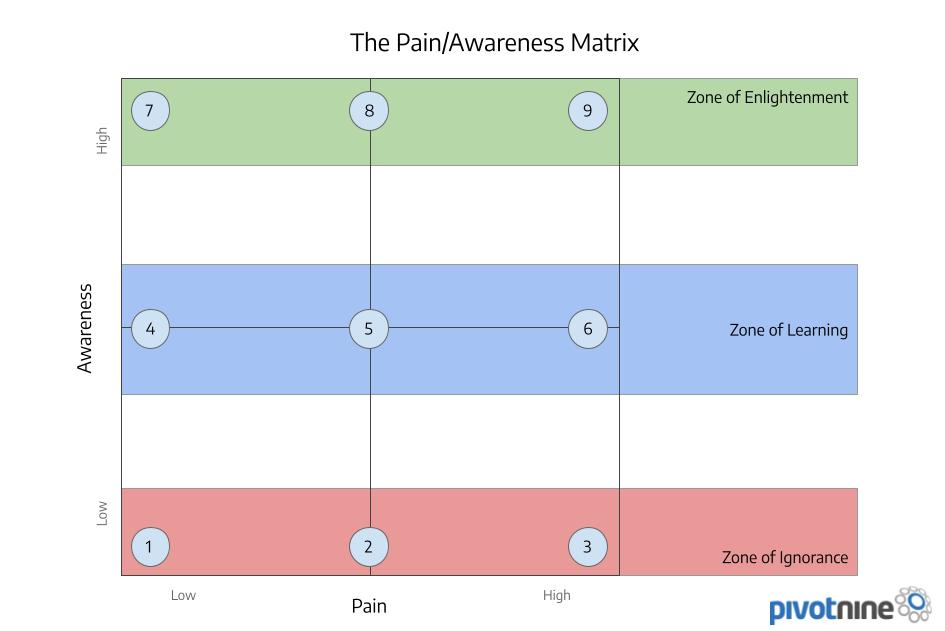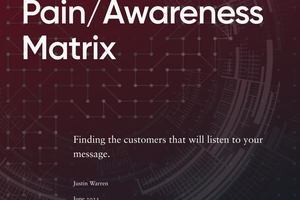Understanding Customer Pain

This article originally appeared as a series of tweets tagged with #pnmt. Follow @pivotnine and @jpwarren for more PivotNine Marketing Tips.
Because we're consultants, we have to have 2×2 matrices to Thought Leadership™ with, but because if it's worth doing it's worth overdoing, we have a 3×3 matrix called the Pain/Awareness matrix. It looks like this:

This matrix is a framework to guide thinking about customers and their awareness of their problems and possible solutions. It's not a guide for how to inflict more pain on customers.
Frameworks get a bad rap because people overuse them. They're supposed to help guide your thinking and sometimes force you to think in ways you don't naturally tend to. They're one way to look at things, not the only way.
All models are wrong, but some are useful.
This silly matrix is designed to guide you to figure out how your customer thinks and feels about the problem they have (that you think you solve because you want to sell them something).
The Zone of Ignorance
In the hilariously named Zone of Ignorance™ people aren't that aware of the nature of their problem. There are three pain levels labelled, as follows:
1: Low pain, low awareness. This problem doesn't affect me, and I don't even know it exists. A state of bliss that we all enjoy right now because can you imagine being fully aware of all the possible pain in the world? What a nightmare!
2: I'm in a bit of pain, but I don't know why. It might not be this problem. Is it cancer or just allergies? Maybe I'm holding it wrong.
3: I'm in a lot of pain and I don't know why. I might think it's this problem but I'm wrong and it's something else.
The Zone of Learning
In the Zone of Learning™, people are a bit more aware of the nature of the problem.
4: I know of the problem, but it doesn't affect me. Also known as the Region of Schadenfreude.
- I'm aware of the problem and it affects me a bit. I have bigger problems, but I'm trying to learn more about the problem so it doesn't get worse. The Region of Self Care.
6: I am in a lot of pain, and have some clues about what the problem is. I'm actively trying to figure it out and fix it.
The Zone of Enlightenment
Then we have the Zone of Enlightenment™ at the top.
-
I am well aware of the problem, in detail, but it doesn't affect me, at least not today. I have moved beyond shadenfreude because I realize just how lucky I am. The Region of There But For the Grace of God Go I
-
I am well aware of the problem as it currently affects me. I can describe my pain in detail and link it to the problem clearly, and I'm working on fixing it, though it might not be my top priority. The Region of Sore But Not On Fire
-
I am in a lot of pain, but I know why, probably in a lot of detail, and I also know what I need to do to fix it, which I am actively doing. Sometimes it takes time to do.
What Does It All Mean?
Why bother doing this analysis? Because sometimes tech people try to sell their Amazing Solution™ to people who don't need it or don't care. That's a waste of their time and yours.
Stop it.
Never teach a pig to sing. It wastes your time and annoys the pig.
Category 1
People in category 1 don't need your thing, and don't care about the problem. If this is seriously your target market something has gone horribly wrong and your company is doomed.
Category 2
People in category 2 aren't ready for you yet. They need to move into category 3 or 5 first: their problem needs to get worse, or they need to learn enough to care more. You can't force them to learn more, though, so don't try. Instead, you should provide a welcoming place to learn more when they feel ready.
Category 4
People in category 4 don't have the problem you solve, and they know they don't. You will only annoy them a lot if you try to sell to them. Leave them alone.
Category 7
People in category 7 just solved this problem so you're too late to sell to them. You can learn from them about how they solved the problem with something else, though, so consider doing that. It's useful market intelligence.
Plus it's possible that the solution they picked doesn't work well long term, so they might be in pain again one day. If you're on friendly terms, they might come back and ask about your thing, so don't antagonise them unnecessarily.
Your Best Prospects
Your best prospects are in categories 3, 5, 6, 8, and 9, so this is where you should start. Especially if you have limited resources, as most startups do. Focus is your friend.
Category 3
Category 3 people are in substantial pain, so removing that pain is of high value to them. But, danger alert, they tend to be unaware of the cause of their pain. This could spell opportunity, or cause problems.
If their mistaken belief is strongly held, it might be hard to convince them your solution is the right one. Starting off by telling a customer they're wrong is generally not a great sales technique, yet lots of tech salespeople insist on using it for some reason.
Besides, what if the customer is right and you're wrong? They are more likely to understand their own circumstances than you are, especially if you're an early stage company.
Your goal for people in category 3 is triage: Can we quickly move them to the Zone of Learning? If not, better to move on, leaving the door open for if they come back on their own.
Category 5 and 6
Categories 5 and 6 are great prospects because they have a basic level of understanding of the problem domain, a demonstrated ability to learn more about it, and are in enough pain to want solutions.
Category 8 and 9
Categories 8 and 9 are well aware of their problem and potential solutions, yet they are still in substantial pain, which means they haven't actually *solved* the problem yet. You should figure out why that is.
If your product is any good, this indicates you have an awareness problem: these potential customers haven't picked you because they don't know you exist! You should fix that!
If they have heard of you, but still haven't picked you, there's something wrong with product/market fit. Are you too expensive? Too cheap? Missing a key feature? Time to figure that out.
Need Help?
If your tech company would like some help with this stuff, you can hire us to do just that. Contact us here.
